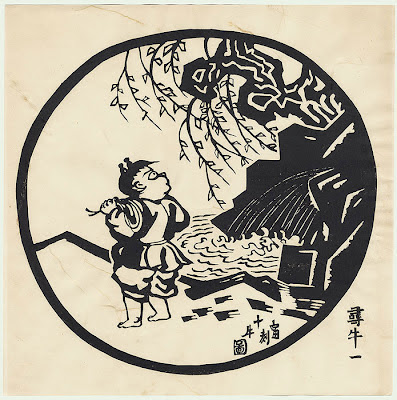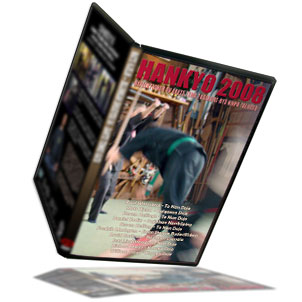From Bujinkan Santa Monica by Michael
When I first studied the 十牛圖頌 ten ox herding pictures and poems, I recognized some of my own journey reflected in Bujinkan training. Maybe you will see yourself there as well.
The Ten Ox Herding pictures illustrate the stages of a Zen life in the quest toward enlightenment. In Zen the ox represents the mind which is at first wild and untamed, running from one thing to another. It is said that these stories are trying to express the inexpressible.
Hatsumi Sensei has a favorite teacup with these ten illustrations on it. As he sips his tea, he says he likes to reminisce about the "old days," and he tells us how we have the same ten stages in our journey through Budo: First dan through Tenth Dan.
This will be the first in a series of 10 posts.
Just as a man would tie to a post
A calf that should be tamed,
Even so here should one tie one's own mind
Tight to the object of mindfulness.
What does it mean to be a Shodan 初段 in the Bujinkan? Let's look at this first stage from the Oxherding perspective:
 |
| Woodblock print by 德力富吉郎 Tokuriki Tomikichirō |
寻牛 The Search for the Bull
In the pasture of the world,
I endlessly push aside the tall
grasses in search of the bull.
Following unnamed rivers,
lost upon the interpenetrating
paths of distant mountains,
My strength failing and my vitality
exhausted, I cannot find the bull.
I only hear the locusts chirping
through the forest at night.
Somehow you find inspiration to start training in the Bujinkan. This may come from a feeling that you are missing something or a need to better yourself. Or maybe that your current training is lacking in some way.
This is known as 初発心 sho-hosshin or the first stirring of the heart.
This goes from first hearing about the Bujinkan all the way through learning your basics so that you start to glimpse that there is an essence to this art that lies beyond technique. These are the footprints you look for while training on the basics. You may not know where they lead, and they remain elusive.
You will be distracted by other styles and many things that are not even related to training. There is so much to absorb that your senses will be confused.
Traps at this stage are thinking you know what is good or bad training, striving to gain rank or prove something, fear that you cannot do things, and giving up the search before you know what you are searching for.
This stage is critical for finding an authentic teacher. You will find the teacher you deserve. If your mind is clouded by what you think is right, you will get a teacher who will only confirm and magnify your ill chosen path.
All of your training will be energetic and have a feeling of really going for it. You get bloody, bruised and sweaty but love the process.
You start to notice that no matter how much you train, there is always more. The Bujinkan seems to expand the more you learn. You never reach the place where you can say, "I've got this." This can lead to a time of doubt where other paths become tempting. You want to find training that you can master and the Bujinkan rarely supplies this feeling.
After your strength and spirit are drained, you wonder, what now? Where can I go from here? How can I keep training and persevere? Can I even do this?
Every visit to the dojo feels like another wasted effort to learn anything. Frustration will rule your mind.
This is a very important passage in training. Reaching this place means you are ready to begin learning. That is why Shodan is beginner's level. You may recognize you are caught in your own conditioning and seek a way out through taijutsu.
You will feel you are nearing the end of this level when you sense that the ego's efforts to capture the essence of training are not enough.
Next we look at
Bujinkan Nidan 弐段: Discovering the Footprints 
…
















